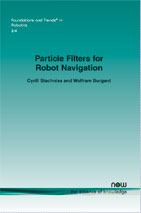Particle Filters for Robot Navigation
By Cyrill Stachniss, University of Freiburg, Germany, stachnis@informatik.uni-freiburg.de | Wolfram Burgard, University of Freiburg, Germany, burgard@informatik.uni-freiburg.de
Abstract
Autonomous navigation is an essential capability for mobile robots. In order to operate robustly, a robot needs to know what the environment looks like, where it is in its environment, and how to navigate in it. This works summarizes approaches that address these three problems and that use particle filters as their main underlying model for representing beliefs. We illustrate that these filters are powerful tools that can robustly estimate the state of the robot and its environment and that it is also well-suited to make decisions about how to navigate in order to minimize its uncertainty of the joint belief about its own position and the state of the environment.
Particle Filters for Robot Navigation
Autonomous navigation is an essential capability for mobile robots. In order to operate robustly, a robot needs to know what the environment looks like, where it is in its environment, and how to navigate within it. Particle Filters for Robot Navigation summarizes approaches that address these three problems and that use particle filters as their main underlying model for representing beliefs. It illustrates that these filters are powerful tools that can robustly estimate the state of the robot and its environment and that they are also well-suited to making decisions about how to navigate in order to minimize a robot’s uncertainty about its own position and the state of the environment. They offer a series of attractive capabilities, including the ability to deal with non-Gaussian distributions and nonlinear sensor and motion models.
Particle filters have been used for almost twenty years in robotics and have become a standard means for a series of tasks. Particle Filters for Robot Navigation is an ideal primer for anyone interested in the research and application of these filters in robotics.
